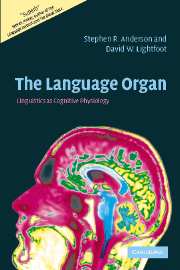Book contents
- Frontmatter
- Contents
- Preface
- 1 Studying the human language faculty
- 2 Language as a mental organ
- 3 Syntax
- 4 Sound patterns in language
- 5 Describing linguistic knowledge
- 6 Phonetics and the I-linguistics of speech
- 7 Morphology
- 8 Language change
- 9 “Growing” a language
- 10 The organic basis of language
- References
- Index
6 - Phonetics and the I-linguistics of speech
Published online by Cambridge University Press: 03 December 2009
- Frontmatter
- Contents
- Preface
- 1 Studying the human language faculty
- 2 Language as a mental organ
- 3 Syntax
- 4 Sound patterns in language
- 5 Describing linguistic knowledge
- 6 Phonetics and the I-linguistics of speech
- 7 Morphology
- 8 Language change
- 9 “Growing” a language
- 10 The organic basis of language
- References
- Index
Summary
Our knowledge of a language is determined by the language organ we develop as a child on the basis of exposure to utterances in that language, and includes what we know about contrasts, relations, and regularities within the set of linguistic objects. Obviously, though, it also includes what we know about the objects themselves. The structure of that knowledge is described by a theory of representations of the various sorts of object that form parts of our language. Seeing the foundation of these representations as an aspect of our knowledge (an I-language point of view) has somewhat different consequences from seeing them as based purely on externally determined properties, part of E-language. There may be much formal similarity between the actual representations that result from these two differing perspectives, but the conceptual content is still quite distinct.
In this chapter, we address the nature of the representations that seem to be most obviously and irreducibly based on observable, physically measurable properties: phonetic representations. We argue that when phonetics is seen as genuinely part of language, rather than a subpart of physics or physiology, the resulting conception of “phonetic representation” (while still recognizable) differs in a number of important ways from what is often taught (or more accurately, assumed) in standard textbooks.
Representations and the study of sound structure
Most linguists assume, as we argued in chapter 4, that the principles of sound structure in a given language mediate between a phonological representation that indicates all and only the properties of an utterance in terms of which it contrasts with other utterances in that language, and a phonetic representation that provides a language-independent characterization of its pronunciation.
- Type
- Chapter
- Information
- The Language OrganLinguistics as Cognitive Physiology, pp. 111 - 130Publisher: Cambridge University PressPrint publication year: 2002

